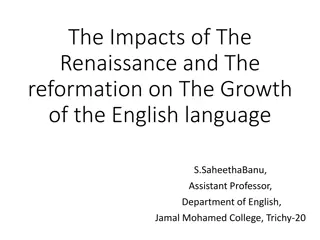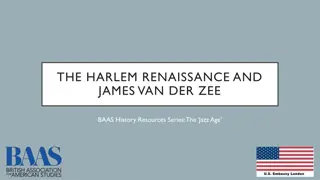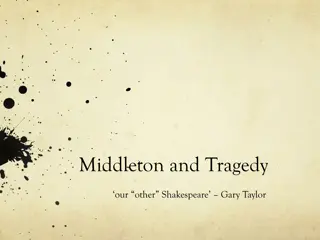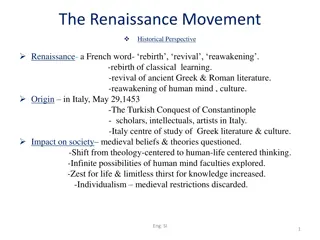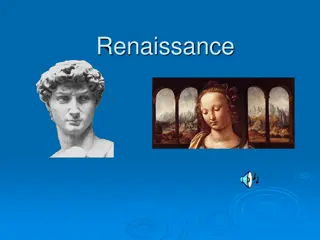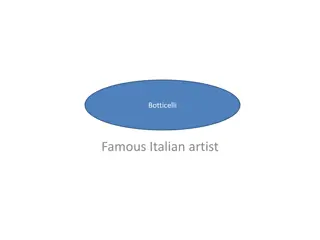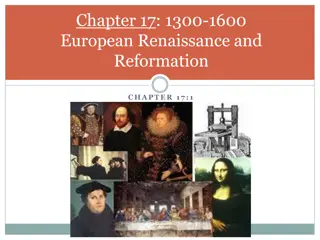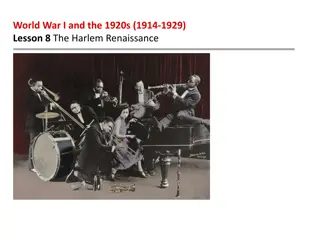Ben Jonson and The Masque of Blackness: A Renaissance Tale
Ben Jonson, a renowned playwright and contemporary of Shakespeare and Donne, led a tumultuous life marked by writing scandals, imprisonment, and notable works like "The Masque of Blackness." Known for his diverse literary contributions and associations with influential figures, Jonson's legacy continues to inspire and entertain audiences today with his wit and imaginative storytelling during the Renaissance era.
Download Presentation

Please find below an Image/Link to download the presentation.
The content on the website is provided AS IS for your information and personal use only. It may not be sold, licensed, or shared on other websites without obtaining consent from the author.If you encounter any issues during the download, it is possible that the publisher has removed the file from their server.
You are allowed to download the files provided on this website for personal or commercial use, subject to the condition that they are used lawfully. All files are the property of their respective owners.
The content on the website is provided AS IS for your information and personal use only. It may not be sold, licensed, or shared on other websites without obtaining consent from the author.
E N D
Presentation Transcript
Week 6 Ben Jonson, The Masque of Blackness, Volpone John Webster, The Duhcess of Malfi
Ben Jonson (1572-1637) He knew and admired John Donne and William Shakespeare Works is his first famous writing Unofficial poet laurete Pension from the king Honorary degrees from Oxford and Cambridge His early life was tough and turbulent Had to leave school for Money He joined the army Jailed for a play too scandalous.
Killed an actor in a duel His popularity grew with James I He was questined for his play Sejanus Jailed for Eastward Ho which mocked the king s Scottish accent and his selling of titles for money. The Masque of Blackness was his first play in the court. Every Man in His Humour Volpone (1606), The Alchemist (1610), Bartholomew Fair (1614) Converted to Catholicism than to Church of England War of the Theatres Colloborations and rivalry in theatre
He died in 1637. Friends with Shakespeare, Donne, and Francis Bacon Sons of Ben Herrick, Carew, Suckling Patrons: Lady Mary Wroth, Sir Walter Raleigh, Families of Sidney and Herbert To Penshurst, a celebration of Robert Sidney s country house Classical inspirations He wrote almost in all genres with a wide imagination
The Masque of Blackness
James I and Queen Anne and their court Court masque as praise, entertainment, political idealization Stuart court as the embodiment of all perfections Colloboration with Inigo Jones Feasts, wedding, celebration, all night dancing Costumes Criticism against this was punished: William Prynne
The cultural superiority of the English over non-European people Celebrates the reign of King James, Sun King of Britain James I can turn black skins to white Orientalism and the women Jacobean masques, glorification of the monarch Jonson invented the prologue Music, costume, design, songs etc. Utter racism Themes of the play
Volpone (1606) A dark satire on human greed Set in Venice The target is City of London Commerce, corruption Greedy fools and rascals Money economy and its effect on the human, theatre, writing and other aspects of social life. Commercial interest
In Volpone Jonson protests the inhumanity of greedy poeple and laws laws made by the greedy to protect the acquisitions of the greedy The state of Venice is more criminal than the criminals itself A mix of themes from various sources Rich old man mocking the other rascals who are after his inheritance. Reynard the Fox Volpone Mosca the parasite Voltore lawyer Corbaccio avaricious dotard (greedy old man) Roman comedy characters
First performed by the Kings Men (Shakespeares company) Globe Theater Classical unity of action, time and place. Volpone is an old man faking to be at the end of his life to lure rascals to rob them off their gifts. Voltore brings an antique plate and is told he will be Volpone's sole heir. Corbaccio and Corvino enter in succession, bringing a bag of gold coins and a pearl, respectively, and are also told that they will be heir to Volpone's fortune.
In the street, Volpone, disguised as a commendatore, torments Corbaccio, Corvino, and Voltore by pretending he has heard news that they inherited a fortune. After being summoned by the Avocatori, Mosca arrives at the Scrutineo and affirms that Volpone is dead. Volpone beseeches him to say that Volpone is still alive, but Mosca demands half of his fortune. When Mosca and Volpone cannot agree to share the fortune, Volpone is apprehended by officers of the court. Before he is led away, however, Volpone unmasks himself and brings Mosca down with him. The Avocatori then hand down punishments to Volpone, Mosca, and the rest of the "clients." To conclude the play, Volpone speaks to the audience and asks for applause.
John Webster (1580?- 1625?)
The White Devil (1608), The Duchess of Malfi (1614) Tragedies set in Roman Catholic Italy representing the Jacobean era Sophisticated corruption and evil characters
The Duchess of Malfi
The Duchess of Malfi is based on an Italian novella. A Jacoean revenge tragedy Senecan tragedy Based on a real story from Italy, Amalfi The Duchess marries Antonio her steward secretly She defies her brothers commands to stay widow Poetry, gothic horror Stage violence Brothers melancholy At the end the stage is full of bodies including Duchess, Antonio and their children Independent spirit and the courage of the Duchess
Class, nobility vs lower classes The corruption of law and religious authority Revenge and evil murders Disguise The violent past of the Italian peninsula Politics and lust for power


